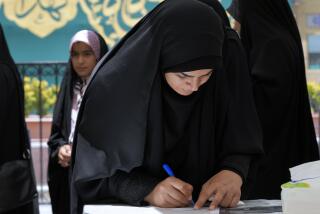Dishing Out Persian
- Share via
NORTH HOLLYWOOD — Zia Atabay sold millions of records as a pop singer in his native Iran and in Europe. But he wanted to be remembered as more than an entertainer.
In March, he launched National Iranian Television, a 24-hour station that broadcasts in Persian throughout the world from a North Hollywood warehouse via satellite.
“I think we can make a change,” said Atabay, 57, chief executive officer of NIT. “We’re going to tell the truth, and I don’t care if some politicians don’t like it.”
The station plans to officially launch its 24-hour format Thursday, with a full slate of programming in Persian, including news, an Oprah-style talk show, a cooking program, cartoons and Iranian movies. It is available only to satellite TV subscribers, he said.
Although there are other local Persian TV stations, National Iranian Television is believed to be the first operating worldwide around the clock. The station’s programming is available by satellite to the estimated 600,000 Los Angeles residents of Iranian descent and millions more internationally.
This is not the first time the Iranian community has gotten into the media business. Last August, the Persian-language radio station KIRN-AM (670) began transmitting to Persian speakers in Southern California.
Parviz G. Afshar, a freelance television producer who has directed and produced programs in Iran and Los Angeles, said he welcomes the new TV station.
“If used properly, it can be very effective,” said Afshar, 58, of Topanga. “In Iran, they close newspapers, and people are not as informed as they should be. [Atabay] has taken a very good step.”
Station to Reach Viewers Worldwide
Atabay of Tarzana has invested about $3 million in his enterprise. He hopes to provide uncensored information to his countrymen in Islamic-ruled Iran, where satellite dishes are illegal, although plenty of people have them anyway, he said.
“Iranian people can’t hear the news from their government,” he said. “Everything is controlled.”
Atabay estimated that 10 million Persian speakers, primarily in the Middle East and Europe, watch NIT, including about 7,000 in Los Angeles. He is in negotiations with cable companies in Los Angeles and England, he said, to offer the station’s programming.
For now, the station’s signal is not scrambled, and viewers can watch it for free. But that will change soon, when Atabay starts charging U.S. viewers $20 a month for the service. The money will be used to maintain the station’s $250,000 monthly budget. A portion also comes from advertisers, such as Los Angeles-based fashion designer Bijan.
Atabay’s life is all-TV, all-the-time. In his office, with Persian almond cookies at his fingertips, Atabay watches five TV monitors transmitting other Persian stations’ programming.
“I want to know what they’re doing. They’re not my competition, but in business you have to watch what they’re doing wrong, so I don’t do it,” he said.
Before getting into television broadcasting, Atabay operated a medical office in Encino with his wife, Parvin, who still runs the business.
In Iran, he had his first hit as a pop music singer at the age of 18 and went on to record other popular albums. He also worked as an artists and repertoire manager for CBS Records in Iran, but lost his job in 1979 when Islamic revolutionaries took over the offices. He fled Iran in 1980, living in Europe before moving to Los Angeles in 1986.
Despite the impact of politics in his life, Atabay said he wants the station to be nonpolitical, a position that has drawn criticism from local Persian groups that want him to take a harder line against the Tehran government.
“Why do I have to change the [Iranian] government?” he asked. “The Iranian people have to change the government.”
Yet avoiding politics may prove difficult when airing news, Afshar said. The station employs about 10 freelance journalists locally and overseas to file news stories.
“I don’t think you can do a program that’s informative and not be political,” Afshar said. “When you talk about news in Iran, whether you like it or not, you get into politics.”
In fact, many of the programs are purely cultural, such as “Cooking With Nader,” which showcases Middle Eastern and Mediterranean recipes.
“We’re trying to show the good things of Iranian culture,” said host Nader Parsia, 47, of West Los Angeles. “We’re trying to add some humor. People are really welcoming it.”
Cooking Show Has Global Appeal
Fans call from as far away as New Zealand, Parsia said, and he receives a steady stream of faxes filled with personal questions, such as: “Are you married?” and “Do you want my daughter?”
Shahbal Shabpareh, leader of the Persian pop band Black Cats, hosts a show with live music and videos. He said the station is important in uniting the 5 million or so Iranians outside Iran.
“It’s being shown in Iran, which is incredible,” said Shabpareh, 59, of Westwood. “Some [Iranians] don’t know where their loved ones are. We need it.”
More to Read
Sign up for Essential California
The most important California stories and recommendations in your inbox every morning.
You may occasionally receive promotional content from the Los Angeles Times.











